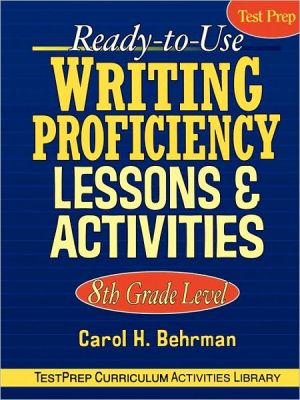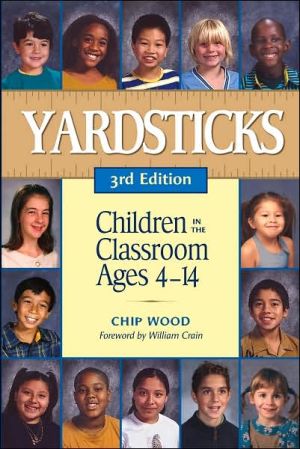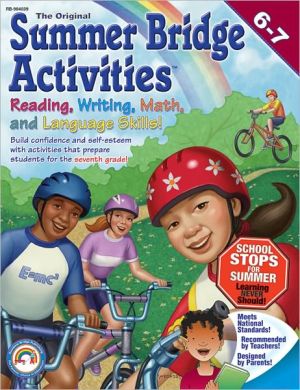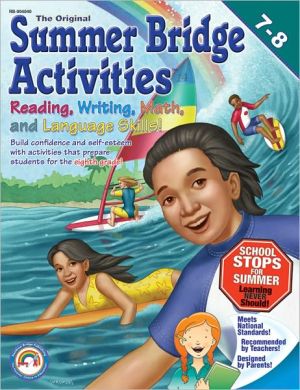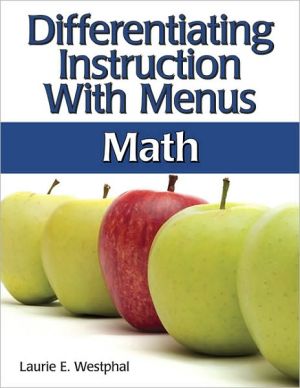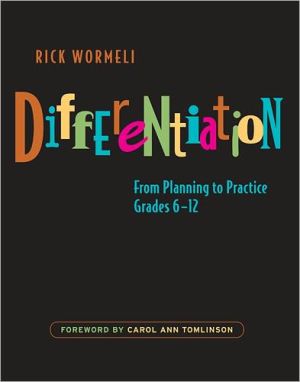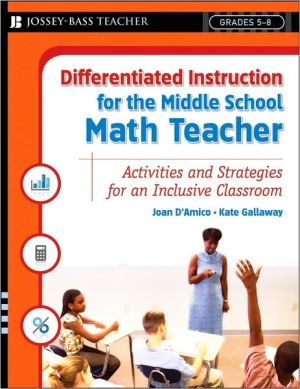Ready-to-Use Writing Proficiency Lessons and Activities: 8th Grade Level
This volume of Ready-to-Use Writing Proficiency Lessons & Activities gives classroom teachers and language arts specialists a powerful and effective tool for addressing curriculum standards and competencies at the eighth-grade level and preparing their students for comprehensive assessment testing.\ Writing Proficiency Lessons & Activities books are also available from Jossey-Bass at the fourth-grade level and the tenth-grade level.\ Included are a variety of easy-to-use, reproducible...
Search in google:
This volume of Ready-to-Use Writing Proficiency Lessons & Activities gives classroom teachers and language arts specialists a powerful and effective tool for addressing curriculum standards and competencies at the eighth-grade level and preparing their students for comprehensive assessment testing. Writing Proficiency Lessons & Activities books are also available from Jossey-Bass at the fourth-grade level and the tenth-grade level. Included are a variety of easy-to-use, reproducible activity sheets that provide application and review the basic language skills as well as extensive practice in producing the types of writing called for in standardized tests. For easy use, the 240-plus student activity sheets are printed in a big 8-1/2" x 11" format that lays flat for photocopying. The activities are organized into nine sections. Here is just a sample of the topics covered in Sections 1-5: CHOOSING THE RIGHT WORD: words often confused, prefixes, suffixes, synonyms, antonyms, homonyms, adverbs vs. adjectives, sensory words, similes, metaphors, and double negatives MAKING MECHANICS AND USAGE WORK FOR YOU: apostrophes, hyphens, end marks, commas, semicolons, colons, quotation marks, titles, and misplaced modifiers. WRITING SENTENCES: subjects and predicates, subject-verb agreement, simple and compound sentences, complex sentences, sentence fragments, run-on sentences, and sentence types WRITING PARAGRAPHS: writing a topic sentence, writing a concluding sentence, developing the topic, using tense consistently, using transitional words, and staying on the topic ESSAY-WRITINGTECHNIQUES: brainstorming, clustering, outlining, writing an introductory paragraph with a question or a surprising statement, developing the topic using examples, avoiding irrelevant details, writing a concluding paragraph, proofreading, and writing a five-paragraph essay.
About This Writing TestPrep Teaching ResourceivSection 1Choosing the Right Word1Teacher Preparation and Lessons1Answer Key61-1Words Commonly Misspelled121-2Words Commonly Misspelled (Part Two)131-3Words Commonly Misspelled (Part Three)141-4Words Commonly Misspelled (Part Four)151-5Words Often Confused161-6Words Often Confused (Part Two)171-7Words Often Confused (Part Three)181-8Prefixes191-9Suffixes201-10Suffixes (Part Two)211-11Suffixes (Part Three)221-12Suffixes (Part Four)231-13Prefixes and Suffixes241-14Synonyms251-15Antonyms261-16Synonyms and Antonyms271-17Homonyms281-18Homonyms (Part Two)291-19Adjectives301-20Adverbs311-21Adverbs vs. Adjectives321-22Prepositions331-23Articles341-24Common and Proper Nouns351-25Collective and Compound Nouns361-26Pronouns and Antecedents371-27Pronouns and Antecedents (Part Two)381-28Indefinite Pronouns391-29Personal Possessive Pronouns401-30Verbs411-31Verbs (Part Two)421-32Verb Tense431-33Irregular Verbs451-34Sensory Words461-35Sensory Words (Part Two)471-36Similes481-37Similes (Part Two)491-38Metaphors501-39Metaphors (Part Two)511-40Compound Words521-41Double Negatives531-42Illiteracies541-43Illiteracies (Part Two)55Review Test: Choosing the Right Word56Section 2Making Mechanics and Usage Work for You61Teacher Preparation and Lessons61Answer Key652-1Plurals702-2Plurals (Part Two)712-3Plurals (Part Three)722-4Capitalization732-5Capitalization (Part Two)742-6Abbreviations752-7Abbreviations (Part Two)762-8Apostrophes772-9Apostrophes (Part Two)782-10Apostrophes (Part Three)792-11Hyphens802-12Hyphens (Part Two)812-13Dashes822-14End Marks832-15End Marks (Part Two)842-16Commas852-17Commas (Part Two)862-18Commas (Part Three)872-19Commas (Part Four)882-20Commas (Part Five)892-21Semicolons902-22Semicolons (Part Two)912-23Colons922-24Colons (Part Two)932-25Quotation Marks942-26Quotation Marks (Part Two)952-27Quotation Marks (Part Three)962-28Quotation Marks (Part Four)972-29Titles982-30Slashes and Ellipses1002-31Parentheses1012-32Avoiding Misplaced Modifiers1022-33Avoiding Misplaced Modifiers (Part Two)103Review Test: Mechanics and Usage104Section 3Writing Sentences109Teacher Preparation and Lessons109Answer Key1133-1Subjects and Predicates1183-2Simple and Complete Subjects1193-3Simple and Complete Predicates1203-4Sentences with One Subject and One Verb1213-5Sentences with Compound Subjects1223-6Sentences with Compound Predicates1233-7Subject-Verb Agreement: Number1243-8Subject-Verb Agreement: Person1253-9Dependent and Independent Clauses1263-10Dependent and Independent Clauses (Part Two)1273-11Dependent and Independent Clauses (Part Three)1283-12Simple Sentences1293-13Compound Sentences1303-14Complex Sentences1313-15Complex Sentences (Part Two)1323-16Simple, Compound, and Complex Sentences1333-17Declarative, Interrogative, Exclamatory, and Imperative Sentences1343-18Declarative, Interrogative, Exclamatory, and Imperative Sentences (Part Two)1353-19Recognizing Sentence Fragments1363-20Recognizing Sentence Fragments (Part Two)1373-21Recognizing Run-on Sentences1383-22Do's and Don'ts for Writing Sentences1393-23Do's and Don'ts for Writing Sentences (Part Two)140Review Test: Writing Sentences141Section 4Writing Paragraphs147Teacher Preparation and Lessons147Answer Key1524-1Organizing a Paragraph1564-2Organizing a Paragraph (Part Two)1574-3Writing a Topic Sentence1584-4Writing a Topic Sentence (Part Two)1594-5Writing a Concluding Sentence1604-6Writing a Concluding Sentence (Part Two)1614-7Developing the Topic1624-8Developing the Topic (Part Two)1634-9Using Tense Consistently1644-10Using Tense Consistently (Part Two)1654-11Using Pronouns Consistently1674-12Using Transitional Words and Phrases1684-13Using Transitional Words and Phrases (Part Two)1694-14Using Transitional Words and Phrases (Part Three)1704-15Staying on the Subject1714-16Staying on the Subject (Part Two)1724-17Avoiding Irrelevant Details1734-18Using Variety in Sentence Length1744-19Using Variety in Sentence Length (Part Two)1754-20Using Variety in Sentence Structure1764-21Using Variety in Sentence Structure (Part Two)1774-22Using a Variety of Sentence Types1784-23Using the Writing Process: Prewriting1794-24Using the Writing Process: Writing the First Draft1804-25Using the Writing Process: Revising and Writing the Final Copy181Practice Test: Writing Paragraphs182Section 5Essay-Writing Techniques189Standardized Testing Information189Teacher Preparation and Lessons190Answer Key1955-1Brainstorming1965-2Brainstorming (Part Two)1975-3Clustering1985-4Clustering (Part Two)1995-5Outlining2005-6Outlining (Part Two)2015-7Stating the Topic2025-8Stating the Topic (Part Two)2035-9Introductory Paragraph with a Question2045-10Introductory Paragraph with a Question (Part Two)2055-11Introductory Paragraph with a Surprising Statement2065-12Introductory Paragraph with an Anecdote2075-13Introductory Paragraph: What Not to Do2085-14Introductory Paragraph: What Not to Do (Part Two)2095-15Developing the Topic Using Examples2105-16Developing the Topic Using Examples (Part Two)2115-17Avoiding Irrelevancies2125-18Avoiding Irrelevancies (Part Two)2135-19Staying on the Subject2145-20Staying on the Subject (Part Two)2155-21Concluding Paragraph2165-22Concluding Paragraph (Part Two)2175-23Avoiding Confusion2185-24Self-Evaluation, Revision, Use of Proofreading Symbols2195-25Writing a Simple Three-Paragraph Essay2205-26Writing a Simple Three-Paragraph Essay (Part Two)2215-27Writing a Five-Paragraph Essay: Brainstorming and First Draft2235-28Writing a Five-Paragraph Essay: Revising and Writing a Final Copy224Practice Test: Essay-Writing Techniques225Section 6Writing Informative Essays231Standardized Testing Information231Teacher Preparation and Lessons2336-1 to 6-3Informative Essay #1: Writing About the School Cafeteria2356-4 to 6-6Informative Essay #2: Writing About a Memorable Class Trip2386-7 to 6-9Informative Essay #3: Writing About Your New Room2416-10 to 6-12Informative Essay #4: Writing About Winning the Lottery2456-13 to 6-15Informative Essay #5: Writing About Becoming a Chef2486-16 to 6-18Informative Essay #6: Writing About Dangerous Situations2516-19 to 6-21Informative Essay #7: Describing a New TV Series2546-22 to 6-24Informative Essay #8: Describing Your Dream Vacation257Practice Test: Writing Informative Essays260Section 7Writing Persuasive Essays265Standardized Testing Information265Teacher Preparation and Lessons2677-1 to 7-3Persuasive Essay #1: Writing an Editorial2697-4 to 7-6Persuasive Essay #2: Entering a Contest2727-7 to 7-9Persuasive Essay #3: Should the Lunch Program Be Changed?2757-10 to 7-12Persuasive Essay #4: Country Living vs. City Living2787-13 to 7-15Persuasive Essay #5: Does Watching TV Affect Students' Grades?2817-16 to 7-18Persuasive Essay #6: Convincing Others to Help Their Country2847-19 to 7-21Persuasive Essay #7: A Park vs. a Shopping Center2877-22 to 7-24Persuasive Essay #8: Writing About School Violence290Practice Test: Writing Persuasive Essays293Section 8Narrative Writing299Standardized Testing Information299Teacher Preparation and Lessons3018-1 to 8-3Narrative Essay #1: A Memorable Experience3038-4 to 8-6Narrative Essay #2: Unfair Treatment3068-7 to 8-9Narrative Essay #3: A Scary Experience3098-10 to 8-12Narrative Essay #4: Through Someone Else's Eyes3128-13 to 8-15Narrative Essay #5: Lost and Found3158-16 to 8-18Narrative Essay #6: Developing the Plot3188-19 to 8-21Narrative Essay #7: Using Dialogue3228-22 to 8-24Narrative Essay #8: Developing the Characters325Practice Test: Narrative Writing328Section 9Writing Letters333Standardized Testing Information333Teacher Preparation and Lessons3349-1 to 9-3Informative Letter #1: Writing to Someone Who's Away3369-4 to 9-6Informative Letter #2: Writing a Fan Letter3409-7 to 9-9Informative Letter #3: Writing to Someone in Another Country3439-10 to 9-12Persuasive Letter #1: Applying for a Job3469-13 to 9-15Persuasive Letter #2: Writing to the Board President3499-16 to 9-18Persuasive Letter #3: Persuading Your Parents352Practice Test: Writing Letters355Proofreading Symbols360AppendixPreparing Your Students for Standardized Proficiency Tests361What Parents Need to Know About Standardized Tests361The Uses of Standardized Tests362Test Terms363Common Types of Standardized Tests365Preparing Your Child for Standardized Tests366Cover Letter to Parents Announcing Standardized Tests367What Students Need to Know About Standardized Tests368Test-taking Tips for Students369Test Words You Should Know370Creating a Positive Test-taking Environment371
